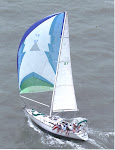Deep Water Cay from MacCleans, Grand Bahama Island
Our Bahamian friends, Paula and Don, took us for a lovely Sunday afternoon tour of the eastern side of their island, Grand Bahama Island. To be truthful, the interior of the island is desolate, undeveloped scrub and scrawny second growth pine. The island was heavily logged in the mid 20th century.
First stop was at the Lucayan National Park where we got a hint of what the island may have looked like originally. This stuff was impenetrable without trails. The Bahamians use the word coppice to mean ecosystem. (The English use a different meaning.) The rocky coppice is occasionally flooded at high tide.
Discussion of the Rocky Coppice
Example of Rocky Coppice
We crossed a wonderful salt water creek with hundreds of fish visible in the shallow, clear water.
Salt water creek in Lucayan National Park
My shadow (lower left) taking a picture of large mangrove snapper
Several hundred yards further on brought us to the lovely Gold Rock Beach on the southern shore of the island. The very deep water Northwest Providence Channel in the background.
Gold Rock Beach looking East
Gold Rock Beach
Then we motored on to the town of Pigeon Settlement and past the homemade light house of the Light House Church of the Later Day Saints. It later showed up on the label of a local beer much to the dismay of the church.
Light House in distance, may need to click on pic to see.
The eastern most settlement on Grand Bahama Island is MacCleans (sic). We had driven about an hour or 50 miles from Freeport. MacCleans has a daily ferry to Abaco Island and several very neatly kept houses, churches, school and a clinic. We found a local restaurant, E. J.'s Bayside Cafe, and were delighted with the cracked conch and the service. Here is a pic of us outside the restaurant. In the unlikely event that you are passing this way (and it is far off the beaten path), I can highly recommend the food.
Karl, Jan, Paula and Don at E. J. 's


















